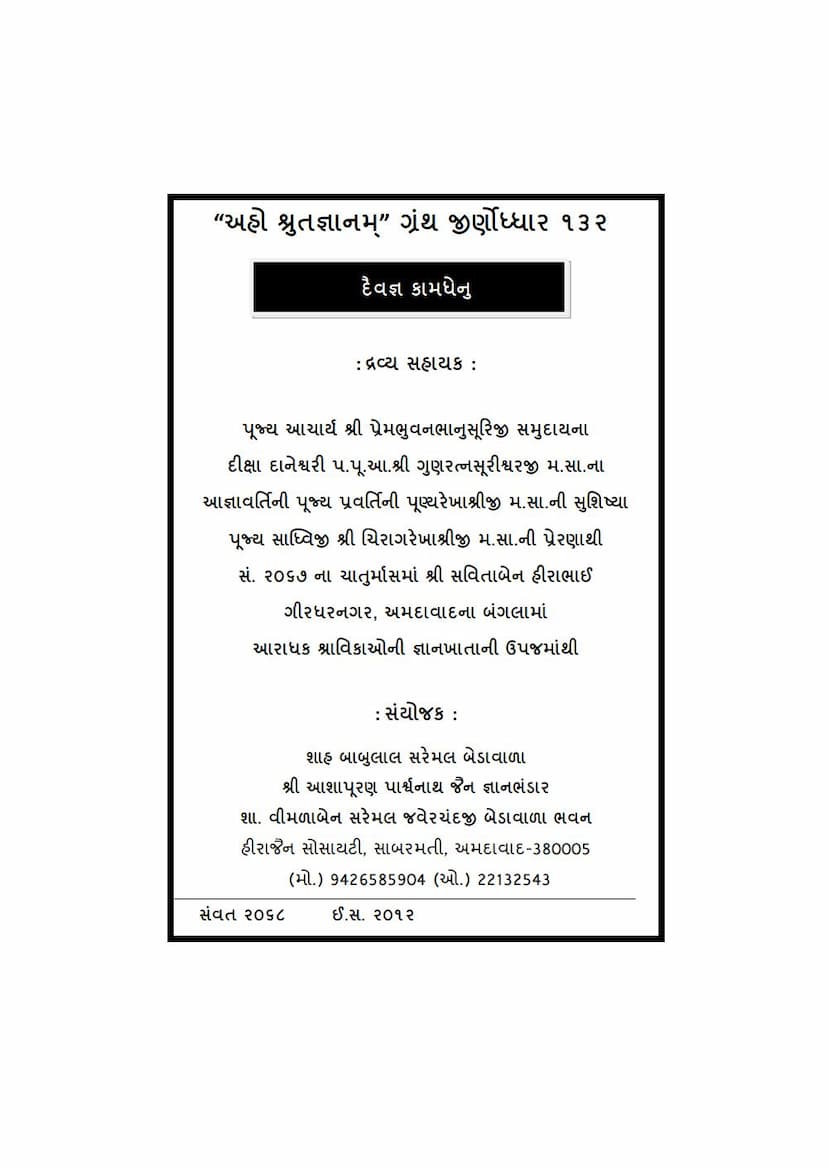Daivagna Kamdhenu
Added to library: September 1, 2025

Summary
Here's a summary of the Jain text "Daivagna Kamadhenu" based on the provided pages:
Title: Daivagna Kamadhenu (दैवज्ञ कामधेनु)
Author: C. A. Seelakkhanda (stated on page #9 and in the preface)
Publisher: Chaukhamba Sanskrit Series Office (stated on page #9 and in the preface)
Nature of the Work:
The "Daivagna Kamadhenu" is presented as an ancient treatise on Astrology (Jyotisha Shastra). The title itself suggests a "cow of divine knowledge" or a source of celestial wisdom, capable of fulfilling desires related to astrological understanding.
Content Overview:
The provided pages offer extensive insight into the scope and structure of this astrological work. It appears to be a comprehensive manual covering various aspects of predictive astrology, likely drawing upon classical Indian astrological traditions. Key areas covered include:
- Introduction and Dedication (Page 1): The initial pages mention the restoration (Jirnoddhar) of the text and acknowledge donors and organizers, particularly highlighting the "Shri Ashapurana Parshvanath Jain Gyan Bhandar" in Ahmedabad. This indicates a modern effort to preserve and disseminate ancient Jain knowledge.
- Catalog of Restored Works (Pages 2-8): A significant portion of the document is a catalog of ancient and rare books that have been scanned and converted into DVDs as part of a "Shrutgyanam Granth Jirnoddhar" project. This catalog includes a wide range of Jain philosophical, grammatical, and scientific texts, with "Daivagna Kamadhenu" listed as item #132. This context suggests the text is part of a larger initiative to revive and make accessible endangered Jain literature.
- The Original Text (Pages 9 onwards): The core of the work begins to unfold from page 9, presenting the astrological treatise itself. The preface (Page 9) confirms its origin in Ceylon and its compilation by Mahamahopadhyaya Shri Anavamadarsi Sangharaja Mahasthavira. It is edited by C. A. Seelakkhanda Sthavira and Seetarama Upadhyaya.
- Astrological Principles and Calculations: The text delves into various astrological concepts, including:
- Calendarical Calculations: Chapters on determining the year, days, and other temporal units (Pages 12-13).
- Planetary Positions and Movements (Graha Gatí): Detailed discussions on calculating planetary longitudes, ephemerides, and their apparent motions (Pages 13-43). This includes concepts like apogee, perigee, and retrograde movements.
- The Zodiac and Houses (Rashi, Bhava): Discussions on the twelve zodiac signs and their characteristics, as well as the concept of houses in astrology (Pages 176-178, 198-201, 206-208).
- Naked Eye Observations and Phenomena: Chapters likely cover eclipses (solar and lunar), their calculation, and their astrological implications (Pages 50-55, 60-66).
- Planetary Influences and Results (Phala): A substantial portion of the text appears to be dedicated to interpreting planetary positions, their interactions, and their effects on individuals and events, likely organized by planetary chapters (e.g., chapters on Mars, Mercury, Jupiter, Venus, Saturn, Rahu - Pages 34-59, 77-88).
- Specific Astrological Techniques: The text details various yogas (planetary combinations), dashas (planetary periods), and specific methods for analyzing horoscopes and predicting outcomes.
- Prognostication and Omens: Chapters discuss omens (Nimitta), dreams (Swapna), bird calls (Vāyas), dog behavior, and other natural phenomena as indicators of future events (Pages 67-98, 121-144).
- Remedial Measures and Mantras: The text includes sections on remedies for afflictions caused by planetary influences, including specific mantras and rituals for appeasing deities and mitigating negative effects (Pages 180-186, 256-261).
- Worship and Rituals: Various rituals for specific occasions like childbirth (Namakarana, Chura-karana), housewarming (Vastu Pravesha), and marriage are described, often involving specific astrological timings and divine invocations (Pages 174-197, 215-238).
- Medical Astrology (Āyurveda and Poison Cures): Remarkably, the text includes detailed sections on treating various ailments, particularly poisonings from snakes, scorpions, and other creatures, suggesting an integration of astrological principles with traditional Indian medicine (Ayurveda) (Pages 253-264).
- The concept of 'Dasas' (Periods): The latter half of the text is heavily focused on planetary dasas, detailing the results of various planetary periods and their sub-periods on an individual's life (Pages 78-88).
- Concluding Remarks and Further Research: The preface and the catalog suggest a continuous effort to study and understand these ancient texts, highlighting the importance of śruta-jñāna (scriptural knowledge) in Jainism.
Key Themes and Significance:
- Preservation of Ancient Knowledge: The project associated with this text emphasizes the Jain community's commitment to preserving valuable ancient scriptures.
- Holistic Approach: The inclusion of medical treatments alongside astrological predictions indicates a holistic worldview where celestial influences are seen as interconnected with physical and spiritual well-being.
- Comprehensive Astrological Guide: The sheer breadth of topics covered suggests "Daivagna Kamadhenu" aims to be a comprehensive resource for astrological practice.
- Jain Philosophical Underpinnings: While primarily an astrological text, its presence within a Jain restoration project implies an alignment with Jain ethical and philosophical principles, perhaps in how astrological knowledge is applied or understood.
In essence, "Daivagna Kamadhenu" is a significant astrological work, preserved and presented by the Jain community, offering detailed insights into the ancient Indian science of celestial prediction and its interwoven connection with daily life, rituals, and even traditional healing practices.